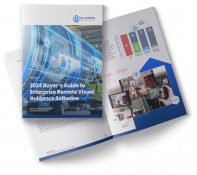Help Lightning Blog
Remote Patient Care: Enabling Medical Staff

Remote patient care is becoming more common – especially after our experience during the pandemic. Getting patients into a medical office can be challenging for multiple reasons. Some patients are physically or emotionally compromised, making it challenging for them to travel from their home to a doctor’s office or medical facility. In many cases, remote patient care is an effective way to treat these patients and support their caregivers. For example, patients who require medical devices and equipment at home can use Help Lightning to enable high-touch patient care in a virtual setting.
Remote Visual Assistance Supports Patient Care
Remote visual assistance technology enables highly effective remote patient care. It provides a merged reality video stream that allows doctors, nurses, patients, and caregivers to work together from anywhere. Both sides can engage with the screen for a 3D view and very specific instruction on how to care for patients and use their medical equipment. This allows patients to get the support they need for the best possible care. And this is without the challenge of having to leave their homes.
Whether in an adjacent hospital room or in another state, remote patient care supports the patient’s needs. It is also helping medical staff be very efficient with their time.
What High Touch Remote Patient Care Looks Like
Remote visual assistance technology allows users to view a merged reality where both sides can engage with the view on the screen. This means doctors, nurses, patients, and caregivers, can engage as if they were side-by-side.
What Visual Remote Guidance Looks Like in a Medical Setting
- A patient just had massive, invasive surgery and is bed-bound for the next 4-weeks. Doctors deemed it safe for the patient to be cared for at home with the proper help.
- The patient’s wife is his main caregiver along with a home health aide. They are responsible for managing the patient’s oxygen machine and intravenous pain medication.
- The patient’s medical care team initiates a Help Lightning call with the patient, his wife, and their medical aid, where they can observe and administer the required care.
- The medical team can reach into the patient’s view to demonstrate how the machines work, what buttons to press, and what to do if a machine isn’t working properly. They can even reach into the screen to point on the spots of the patient’s body that machines are hooked up to.
- The wife is able to have all questions addressed, and she received very specific, expert training. She is now well equipped to be a solid caregiver alongside the home health aide.
The patient remains in the comfort of their home and did not suffer an unnecessary move. The medical staff was able to conduct this visit quickly and efficiently.
Remote Patient Care Benefits Medical Providers, Patients, and Caregivers
Remote visual assistance technology makes remote patient care more dynamic and high touch than it’s ever been before. This goes well beyond a 2D telehealth appointment. It merges the patient’s environment with the medical provider’s for a shared reality. This allows for effective care and ensures at-home medical devices are in appropriate use.
Medical professionals have the ability to engage patients and caregivers to ensure care is being properly executed. Both sides of the screen can engage in a merged virtual reality, making collaboration feel as if it’s in person.
Remote patient care supports several Key Performance Indicators (KPIs) in medical settings.
The KPIs Help Lightning Customers Experience:
- Reduced costs per patient encounter
- Increased revenue for the medical facility
- Higher Net Promoter Score (NPS)
- Decreased no show or missed appointment rates
- Better patient communication
- Improved patient care
Interested in learning about more use cases and how other companies are using remote visual assistance? Review our full list of 20 remote assistance use cases. Also, download our shareable guide on remote assistance software use cases.
Contact Help Lightning to Learn More
Remote visual assistance technology makes it possible for medical teams to effectively collaborate on patient care with the patient’s themselves and their caregivers.
Contact us for a free, no obligation demo of Help Lightning.
Our team is waiting to show you exactly how Help Lightning’s remote visual assistance software can help the specific needs of your medical facility.












